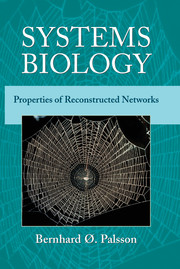Book contents
- Frontmatter
- Contents
- Preface
- 1 Introduction
- 2 Basic Concepts in Systems Biology
- PART I RECONSTRUCTION OF BIOCHEMICAL NETWORKS
- 3 Metabolic Networks
- 4 Transcriptional Regulatory Networks
- 5 Signaling Networks
- PART II MATHEMATICAL REPRESENTATION OF RECONSTRUCTED NETWORKS
- PART III CAPABILITIES OF RECONSTRUCTED NETWORKS
- APPENDIX A Nomenclature and Abbreviations
- APPENDIX B E. coli Core Metabolic Network
- Bibliography
- Index
3 - Metabolic Networks
from PART I - RECONSTRUCTION OF BIOCHEMICAL NETWORKS
Published online by Cambridge University Press: 05 September 2012
- Frontmatter
- Contents
- Preface
- 1 Introduction
- 2 Basic Concepts in Systems Biology
- PART I RECONSTRUCTION OF BIOCHEMICAL NETWORKS
- 3 Metabolic Networks
- 4 Transcriptional Regulatory Networks
- 5 Signaling Networks
- PART II MATHEMATICAL REPRESENTATION OF RECONSTRUCTED NETWORKS
- PART III CAPABILITIES OF RECONSTRUCTED NETWORKS
- APPENDIX A Nomenclature and Abbreviations
- APPENDIX B E. coli Core Metabolic Network
- Bibliography
- Index
Summary
The function of cells is based on complex networks of interacting chemical reactions carefully organized in space and time. These biochemical reaction networks produce observable cellular functions. Network reconstruction is the process of identifying all the reactions that comprise a network. The reconstruction process for metabolic networks has been developed and implemented for a number of organisms. The main features of metabolic network reconstruction are described in this chapter. We briefly review the key properties of metabolic networks and introduce the hierarchical thinking that goes into the interpretation of complex network functions. Further details can be found in authoritative sources.
As discussed at the end of this chapter, a true genome-scale reconstruction of cellular functions necessitates accounting for all cellular networks simultaneously. Such a comprehensive network reconstruction has yet to be established; therefore, in this chapter, we focus on metabolism and address the reconstruction of transcriptional regulatory and signaling networks in the following two chapters.
Basic Features
Intermediary metabolism can be viewed as a chemical “engine” that converts available raw materials into energy as well as the building blocks needed to produce biological structures, maintain cells, and carry out various cellular functions. This chemical engine is highly dynamic, obeys the laws of physics and chemistry, and is thus limited by various physicochemical constraints. It also has an elaborate regulatory structure that allows it to respond to a variety of external perturbations.
- Type
- Chapter
- Information
- Systems BiologyProperties of Reconstructed Networks, pp. 29 - 53Publisher: Cambridge University PressPrint publication year: 2006



